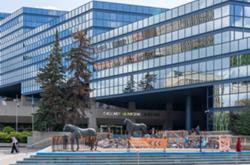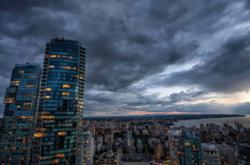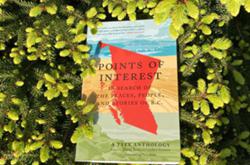
If the devil's in the details, we're still a hell of a long way from having a rigorous plan to fight global warming.
The provincial government unveiled legislation Tuesday that sets out its goals for cutting climate-changing emissions.
But if anyone expected that legislation to contain details of where and how the cuts will be made, they will have been disappointed.
The government gave statutory authority to the targets while announcing its long-awaited climate action team.
These are both significant moves. But they are only the first steps toward a detailed plan.
The need for such a plan is stressed in a recent report from the Pembina Institute. The report, titled Mind the Gap, looks at what's been done so far to cut emissions in B.C. and what can be done in the future.
The title of the report alludes to the gap between what the provincial government's done so far to cut emissions and what's needed to reach its targets.
Government miffed
The Pembina report irked the government, which immediately claimed that it's not being recognized for its plans to cut greenhouse gas emissions.
The report "doesn't give us credit for a number of things that we've announced and we've said we'll legislate in the near term," groused Graham Whitmarsh, the head of the government's Climate Action Secretariat.
Then Premier Gordon Campbell weighed in, telling the Vancouver Sun that he was "pretty disappointed" with the report.
"I think there is work we've already done that they haven't recognized in the report and that's a shame," Campbell said. "I thought they were much more diligent, and frankly far more professional than that."
While the report could identify concrete government plans for only 5 million tonnes of annual emissions cuts, Campbell's government claims it has set out cuts ranging between 24 and 33 million tonnes.
Now that's a gap.
Details lacking
Pembina senior analyst Matt Horne told The Tyee that the report's authors were trying to stay away from a "shouting match" with the government.
The report isn't intended to say "this should all have been decided by now," he said.
However, a number of the government's initiatives just aren't detailed enough to be counted, Horne said.
For example, Whitmarsh argued that Mind the Gap doesn't give the government credit for the seven to 10 million tonnes of annual cuts it intends to get from the Western Climate Initiative (WCI) cap-and-trade program.
Horne said the report acknowledges that the government has joined the WCI. And he said the cap-and-trade program may well turn out to reduce emissions by seven to 10 million tonnes.
"At the moment, though, the WCI process is at a very preliminary stage," he said. "Until there's some really clear constraints on how it's going to impact B.C. and B.C.'s large emitters, the devil really is in the details in terms of what that policy is going to look like."
While there are a number of "subjective judgments" around the government's announcements, Horne said, "I don't think any of those subjective judgments change our general message, which is that a number of the key pieces, even though they may be at early stages on the drawing board, aren't anywhere near developed enough to be given credit for."
In the throne speech and in Tuesday's legislation, the government pledged to cut B.C.'s emissions by 33 per cent below current levels by 2020.
That means cutting at least 36 million tonnes from the province's annual emissions, the Mind the Gap report calculates. (Other projections, based on faster economic and population growth, have put the figure at around 40 million tonnes a year.)
Charging to pollute
The Mind the Gap report identifies 39 million tonnes that can be cut "if the B.C. government and British Columbians are prepared to make real changes."
The cuts will require "real leadership from the B.C. government, through laws, regulations and policies that will establish economic signals to ensure that polluting our atmosphere with greenhouse gases is no longer free."
The government, the report says, "must enact policies to undertake all its announced strategies.
"Many initiatives have been announced but most of them lack details on implementation," the report says. These commitments need "effective follow through by government policy so that individuals and business can act.
"We need to know what will be done, how it will be done, how success will be measured and what will be done if initial steps do not succeed."
Meeting the targets will involve the whole economy and will "significantly transform our society," the report says.
"We will need to redesign our urban communities, our transportation systems, and the ways in which we produce and distribute the goods and services we all rely on."
The transition will have deep effects on communities, workers and families and these effects will need to be cushioned to ensure that some are not forced to carry an unfair share of the burden.
"There is also a need to ensure that workers and communities obtain a fair share of the benefits that will result from a properly managed and just transition."
Carbon taxes
The report contains 20 recommendations, including:
- A "strong emissions pricing mechanism, such as a carbon tax and/or cap-and-trade system."
- Regulations to "drive companies to make changes in advance of, or as a complement to" carbon taxes or cap and trade.
- Vehicle emission standards that are even more stringent than California standards.
- A "strong system of rebates and extra charges on all personal vehicles, based on their energy efficiency."
- Provincial and local government requirements that new housing developments minimize greenhouse gas impacts and offer alternatives to car travel.
- Carbon taxes on gasoline or pay-as-you-go car insurance, designed to encourage people to drive less.
- Energy efficiency and renewable energy performance standards for all new and existing homes and other buildings.
- Targeted price rebates and charges aimed at the construction and renovation of buildings
- A modest carbon tax on home and building energy bills, "levied in proportion to the emissions generated from heating, cooling and all other services in the building."
The report also warns that reaching the targets for 2020 is simply the first step. It notes that meeting the throne speech goal for 2020 will reduce B.C.'s annual emissions to 10 per cent below 1990 levels.
To avoid the worst effects of global warming, Canada needs to cut its emissions to 80 per cent below 1990 levels by 2050, the report states.
Tuesday's legislation sets a target for 2050 of at least 80 per cent below 2007 levels -- substantially short of the goal recommended by the Pembina Institute.
Related Tyee stories:
- Global Warming Demands Local Fixes
Half of greenhouse emissions are controlled at municipal level. - Denial as Projections Place BC Cities Under Water
Dyke plans, property values don't reflect sea rise predictions - Global Warming's Threat to BC: Seeking Solutions
Floods and droughts on the radar. Can we adapt?














Tyee Commenting Guidelines
Comments that violate guidelines risk being deleted, and violations may result in a temporary or permanent user ban. Maintain the spirit of good conversation to stay in the discussion.
*Please note The Tyee is not a forum for spreading misinformation about COVID-19, denying its existence or minimizing its risk to public health.
Do:
Do not: